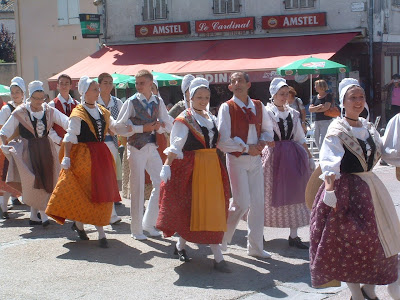
As I think I’ve said before (ad infinitum probably) September and October are the best months to be here in the Haute Garonne. There are three main reasons: the tourists have gone home (sorry tourists... love to see you come, love to see you go), the weather is absolutely, gloriously warm and mellow and we are awash with nature’s bounty.
I’ve been on the receiving end of ‘all good gifts around us’ this week and while they may have been ‘sent from heaven above’ they have been delivered by my lovely friends and neighbours.
It’s amazing what a few straggly cabbage plants can bring forth. Capt. Sensible had some left over in the spring, and rather than throw them away he gave them to Serge, who keeps chickens and has a ‘potager’ close to our garden. Serge speaks no English, Capt Sensible speaks no French, but so far we have had in return, an abundance of ‘salade’, some melons, haricot vert and just this weekend enough tomatoes, aubergines, peppers and courgettes to make ratatouille for the entire village… or so it seemed.
I’ve also been on the receiving end of some delicious plums. The only problem was my small freezer was jam packed with a whole load of apricots which were going cheap on the market …9 kilo trays for €5. Well, that was too good for Capt Sensible to turn down, despite my weak protests that the freezer was full of home- grown raspberries.
If the plums can’t be frozen they can be turned into plum brandy…. you can see the way my mind works, can’t you?
I worked out that if I got going sharpish we could have some plum liqueur in time for Christmas.
I’d got the vital ingredients – plums (d’accord) sugar and brandy (purloined from Capt Sensible’s personal supply). Not his best French of course (I value my life) but the Terres Spanish stuff he has for ordinary consumption. I needed vodka - pas de problem and a container large enough to hold a couple of pounds of plums plus the sugar and alcohol. That was a bit of a problem, but then I remembered a rumtopf pot which I hadn’t used for years. I’d had a bit of a disaster on the only occasion I’d attempted preserve plums, apricots and peaches in the manner described in the recipe that came with it. The fruit went mouldy, the alcohol had secondary and ‘thirdary’ fermentation and the rumtopf became a breeding ground for botulism. It spent the next few years gathering dust as a kitchen ornament until, for some unexplained reason, I paid good money to transport it to France with all the other bits of junk that I foolishly thought might come in useful one day.
And so it has, but I don’t intend to leave the plums in any longer than necessary.
If you have an over-abundance of plums there’s just time to turn them into a Christmas liqueur. This recipe is very simple, and just the thing to warm you up after a chilly day in the mountains.

You’ll need a large macerating container with a lid ... a 1 litre kilner jar is ideal if you haven’t got a rumptopf crock,
and :
a kilo of plums
450 gms white sugar
500 ml. vodka
125 ml. brandy.
Wash, dry, halve and de-stone the plums. Place in the jar, layering with the sugar, then add the alcohol. Stir gently to mix the liquid and fruit, put on the lid and leave in a cool dark place for 2 months. Strain the liquid through a muslin cloth into a large jug, cover and leave to settle in a cool place overnight and then strain again. Bottle and leave for another 4 weeks. The liqueur should be port wine coloured and crystal clear, if it’s not, leave another week or two.
On Friday when Serge’s wife Martine turned up with the peppers, aubergines etc. the timing couldn’t have been better, as I had a roast shoulder of lamb planned for the weekend. I love ratatouille with lamb, and Serge had come up with all the ingredients.
This is my haphazard recipe for ratatouille:
I cut the courgettes,peppers and aubergines in half, leaving the tomatoes whole, and pour over a little olive oil. This time I used lemon flavoured oil(just because I had some in the cupboard), but you could use chilli oil for a bit of spicy heat.

I put all the veg in a big roasting tin, throw on some unpeeled garlic cloves (I like lots, but it’s a personal choice) some sprigs of thyme, a few roughly torn basil leaves and roast for about 20 mins in a hot oven.
When the veggies are nicely brown and beginning to go soft I take them out of the oven, leave to cool, then cut the peppers, courgettes and aubergines into cubes(large or small as you like) and skin the tomatoes. I squidge the garlic, which should be soft and squidgeable, onto the peeled tomatoes and mash them up a bit with a little more oil. This is then poured over the cubed vegetable, given a quick stir and spooned into a serving dish. You can serve it straight away at room temperature as part of a vegetarian lunch or, as I do, leave overnight in the fridge and re-heat in the oven and serve with the lamb. I think roasting the vegetables first, and leaving overnight increases the flavour. And beats the tinned ‘rat’ into a cocked hat.
































